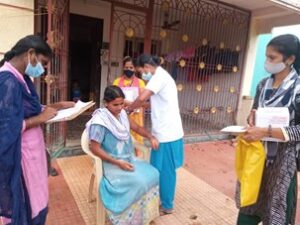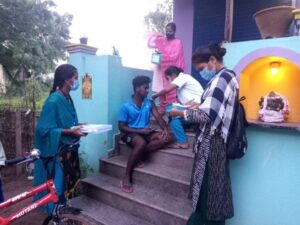Successful COVID-19 Vaccination, Primary Health Centre, Sorapet
By Shankar K
This article details how the vaccination efforts of Azim Premji Foundation, Puducherry dovetailed the Sorapet Primary Health Centre’s (PHCs) COVID-19 vaccination efforts.
Geographical Context
Sorapet is a large village located in Mannadipet Taluk Commune of the Puducherry district, with a total of 1202 families comprising a population of approximately 10,000 individuals. Out of the total population, 82.33 percent of workers describe their primary work (providing a livelihood for more than six months) as agriculture and allied activities, while 17.67 percent are involved in marginal activities, like daily wage or construction labour (providing a livelihood for less than six months).
The Primary Health Centre (PHC) Sorapet is a rural location about 25 km from the District Headquarters. This PHC oversees four village panchayats, namely, Vambupet, Sorapet, Vinayagampet and Sellipet. The majority of the population relies on this PHC and its subcentre situated in Sellipet for health care facilities because of the ease in accessibility, availability and affordability. Special clinic days, like an antenatal clinic day on Wednesdays, immunisation clinic on Thursdays, NCD (non-communicable diseases) clinic on Tuesdays, Fridays and an Adolescent clinic on Saturdays, are held at the PHC.
Scope of vaccination initiative support
Getting everyone vaccinated has direct and indirect impacts on society, like low infection rate, fewer chances of public lockdown and school closure etc. But the pace of vaccination in Puducherry was slow during the mid of the year 2021. In the midst of the COVID-19 crisis, Azim Premji Foundation, Puducherry began supporting the Department of Health and Family Welfare, Puducherry through its various efforts like providing medical equipment and creating awareness posters.
Figure 1. Progression of vaccination
To extend the support and to ensure speedy vaccination for the eligible population, a ‘Vaccination Initiative’ was launched by the Azim Premji Foundation across the states. The initial deliberation between the Health Department and the Foundation members in Puducherry was over PHC-wise vaccination data, population numbers, and the possible supportive measures that we could provide, to collaboratively ensure a higher rate of vaccination among the population. Based on this deliberation, PHCs were categorised based on their vaccination rate and population coverage. And the rollout began in a phased manner.
From the initial deliberation with the Medical Officer, we got to know the efforts taken by the PHC for enhancing the vaccination rate in the respective villages. The Medical officer also shared field challenges, such as the lack of a dedicated mobile vaccination team, gaps in the data update on the COWIN portal etc. In the month of October 2021, the first dose coverage as per the PHC was 90 percent and the second dose 20 percent. But this did not reflect in the COWIN portal due to the backlog in the portal entry. Based on the vaccination percentage, Azim Premji Foundation provided human resource support to augment the existing teams at the PHC, that is, one Vaccinator, one Data Entry Operator (DEO), one Community Health Worker (CHW) and six volunteers for three months (October to December). Within a month a need was felt for a few more resources for vaccination and data entry and management and these were also provided.
Optimal utilisation of provided manpower by PHC
Being a rural catchment area, we found that vaccine hesitancy was high among the local people. The reasons for this included fear of post-vaccination effects, false beliefs that vaccination may cause death etc. In order to address these apprehensions and to convince the public was a big challenge for the team. Hence, vaccination initiative staff took up the CASE approach1 to address vaccine hesitancy. Additionally, Auxiliary Nurse Midwives (ANMs) and Accredited Social Health Activists (ASHAs) shared their field experiences and challenges during a one-day orientation. This helped them in addressing the vaccine hesitancy in the field. These persuasive efforts lead to better outcomes. Despite these efforts, some parts of the population were still hesitant. With the help of the Medical Officer, these people were also vaccinated during the door-to-door vaccination campaign.
Figure 2. Field plan for vaccination
The idea of door-to-door vaccination through a dedicated team along with the PHC’s ANMs and ASHAs ensured vaccine accessibility and addressed the vaccine hesitancy. The door-to-door vaccination during the evening time reaped better results. The dedicated vaccination team consisted of a minimum of five members (one vaccinator, one DEO, two volunteers and one PHC staff). The size of the team itself helped people to feel convinced during the door-to-door vaccination. It also helped in vaccinating the working population in their homes itself. Moreover, MGNREGS worksite vaccination was also carried out on Fridays.
The above-mentioned field efforts were planned with concerned medical officers by the deployed Community Health Workers (CHWs) and the support of PHC staff was ensured during the field vaccination. The habitation selection was made using the VAXIT overdue data. Transport support for door-to-door vaccination was also provided for enhancing the vaccination rate. A few challenges, like getting support from the PHC staff in the initial days, addressing the vaccination hesitancy in the field, and vaccination in the evening were big challenges for the members.
Figure 3. Household vaccination drive data
Roll out of household vaccination survey
With the objective of ‘no one is left behind’ in this vaccination journey, a household survey was planned with 15 surveyors and surveyors DEO in all habitations of the PHC. The household survey orientation was given by the Foundation members along with the medical officer. This ten-day household survey was monitored and supported by the PHC-ASHAs and ANMs. Subsequently, the collected raw data were typed by the surveyor DEOs and the cleaned-up data was uploaded to the VaxIT portal.


Data driven-vaccination planning
The access to VAXIT Mobile Application was given to all ‘vaccination initiatives’ staff members. The habitation-wise, age-group-wise vaccination data and second dose overdue count helped the PHC to plan the door-to-door vaccination strategically. Periodical phone calls to the overdue members were done by recruited volunteers. The timely update of vaccination status in the VAXIT portal was also executed by the members. The Medical Officer himself monitored the progress of the VAXIT mobile application. Our suggestions and possible interventions were also given to the Medical Officer during the field visits and review meetings.
Figure 4. Household vaccination drive data for persons above 60 years.
Synergically, efforts were being made by the Sorapet PHC and the vaccination initiative staff to achieve a ‘fully-vaccinated’ status. From the beginning, the objective of providing human resource to PHC was made clear and hence, they were not engaged in any other responsibilities or work of PHC. In every process, the Foundation involved the PHC staff to ensure their consensus. For example, the Medical Officer along with the Foundation members led the interview of candidates and supported the candidate selection; ASHA and ANM participated in the orientation programme and shared their field challenges with the newly recruited human resources etc.
The challenges faced by the members, insights of periodical review and data inferences were discussed with the Medical Officer to find possible consensus solutions. In the month of December 2021, the PHC’s first dose coverage crossed 90 percent, hence, with the consent of the PHC Medical Officer, the Foundation initiated a phased exit of our members. In the month of February 2022, the Foundation extended its support by again providing one vaccinator, one DEO and one volunteer to rectify the data gap in the portal and support the second dose coverage. At the end of March 2022, the vaccination status of Sorapet PHC was –first dose 99 percent (as per VAXIT) and second dose, 93 percent (as per VAXIT). The data available with PHC, COWIN portal and VAXIT matched to a large extent (with minimal differences).
AUTHOR
Shankar K is a Tamil Resource person in Azim Premji Foundation, Puducherry. His interest-areas cover innovations in assessments and meaningful language teaching. He worked with the Sorapet PHC during the implementation of the COVID-19 vaccination initiative.
Featured photo by Towfiqu barbhuiya on Unsplash

